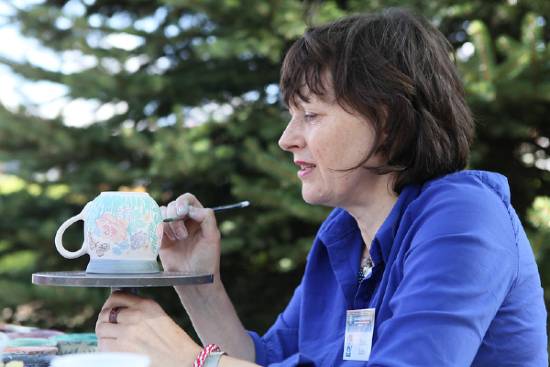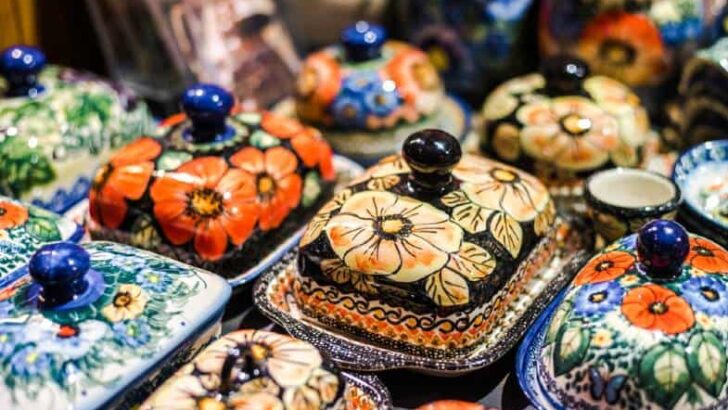Polish pottery is famous for being hand-made and hand-painted by skilled artisans. It is rare to find one piece that is exactly the same as the other, as each piece is a product of an individual artist. You may have heard of UNIKAT Polish pottery and wondered what it is. Here’s what you need to know…
Pieces created by the most skilled and experienced artisans are called “UNIKAT” pieces. Directly translated, “UNIKAT” is Polish for “unique .”These pieces take the longest to produce and exhibit the most detailed and intricate designs. Due to the expertise required to create UNIKAT pieces, they are few and far between and, subsequently, highly-priced.
UNIKAT pottery is popular with collectors of Polish pottery, and quite often, they end up as display pieces. By the end of this article, you will better understand UNIKAT Polish pottery and exactly why it is said to be unique.

UNIKAT Polish Pottery – How is it Different?
Ceramika Artystyczna, the biggest Polish pottery factory, groups Boleslawiec pottery into two main groups: traditional and UNIKAT. Boleslawiec pottery is the other name for Polish pottery, as Boleslawiec is the town where the art originated from.
Traditional polish pottery is simpler in design than UNIKAT pottery at face value. The difference in complexity is because of the methods used in the creation process, the time taken, and the artists’ level of skill and expertise.
Artisans use the punching technique to decorate traditional polish pottery, resulting in basic motifs which are relatively common. On the other hand, UNIKAT pieces are a result of brushwork, which requires more skill and produces superior designs.
Furthermore, traditional Polish pottery is inspired by traditional decoration based on a peacock’s feather. Thus, most designs feature blue patterns on a cream-white background. Elsewhere, UNIKAT decoration is more versatile, and unpredictable, and often features other colors alongside blue.
All Polish pottery – traditional and UNIKAT- is hand-made. Usually, it takes more than a pair of hands to create a traditional piece – the designer is rarely ever the painter. Elsewhere, one person orchestrates the process of making a UNIKAT piece, whereby the designer is also the painter of the vessel. Hence, UNIKAT pieces take way longer to produce, and only those who have achieved the highest level of skill can create them.
One major difference between traditional and UNIKAT polish pottery is the value of the pieces. UNIKAT pieces are priced way higher than traditional pieces for the reasons stated above. Also, as earlier indicated, UNIKAT pieces are mainly used for display as opposed to everyday use, as is the case with traditional Polish pottery vessels.
How to Identify UNIKAT Pottery
All Polish pottery is marked “Hand made in Poland” at the bottom of the vessel. UNIKAT pieces have an additional “UNIKAT” stamp to indicate that it is a unique piece. In addition, it features the piece’s pattern number and the artist’s initials, or full name, depending on the quality level of the UNIKAT vessel.
Some UNIKAT pieces are labeled “Ltd Ed” to indicate that they are extremely rare.
At the very bottom of all this information is an alpha-numeric code that contains the painter’s initials followed by a unique number.
Nevertheless, the most obvious indication that a piece of polish pottery is a UNIKAT vessel is the inscription “UNIKAT .”Other than that, the patterns and quality of the design are also indications that a piece is unique.
Most UNIKAT pieces boast intricate, sophisticated details that set them apart from traditional Polish pottery. UNIKAT artists undergo years of intense training to sharpen their pottery skills, so their products are visibly high-quality.
What is Signature UNIKAT?
Signature UNIKAT is Polish pottery of the highest level of artistry. It is created by extremely talented artists who enjoy the privilege of working on their designs from beginning to end. Thus, these pieces are very limited, and each of them is a remarkable work of art with fine designs.
Instead of just initials, the artists sign the pieces using their full names. Also, the pieces are incredibly unique as they are hand-made and reflect the style and inspiration of a particular artist.
Levels of UNIKAT Polish Pottery
There are eight stratifications of UNIKAT Polish pottery as per the intricacy of the patterns. The levels are set by Ceramika Artystyczna and include U2,U3,U4,U5,U6,U7,U8, and limited edition. These levels are discussed below:
U2: This is the least detailed level of UNIKAT Polish pottery as it is not very intricately made. Usually, it is grouped together with traditional pieces and even priced the same.
U3 and U4: These two levels are grouped together as they showcase the same degree of artistry. They have better quality than U2 pieces and are priced as ‘regular’ pieces by the Ceramika artystyczna factory.
U5- U8: Pieces in these levels exhibit a high level of artistry. The intricacy of design increases gradually from level U5 to level U8 even though they are grouped together. There is a significant investment in time and skill, and subsequently, these pieces are highly-priced.
Limited Edition: These pieces take the longest to create. As a result, they feature gorgeous designs and, ultimately, are the most expensive. They are referred to as ‘limited edition’ because there are rare. Furthermore, they have not been in production since mid-2021. Limited edition UNIKAT pieces are museum-quality and are highly sought after by art collectors.
Why UNIKAT Pottery is Costly
As with all types of products, the higher the quality, the higher the price. UNIKAT Polish pottery is of higher quality than traditional Polish pottery, and hence, it costs more. As we have already established in this article, a significant amount of time and skill goes into creating a piece of UNIKAT pottery.
Therefore, the pieces are breathtaking as the designs are intricately detailed and extremely unique. Often, UNIKAT pieces are used as display items because of their aesthetic quality. In other instances, they are passed down as family heirlooms, which significantly increases their value.
Final Thoughts
UNIKAT Polish pottery is a refined type of Boleslawiec pottery that incorporates top-level skills and intricate designs. These pieces are marked “UNIKAT” at the bottom to set them apart from traditional Polish pottery.
There are eight levels of UNIKAT Polish pottery according to the level of expertise as detailed in this article. The lowest of the levels is U2, while the highest, which features the finest design, is the ‘Limited Edition.’
UNIKAT Polish pottery is significantly pricier than traditional Polish pottery because of the time and skill put into them. It takes years of training for an artist to be able to design and create a UNIKAT piece from scratch to completion.







